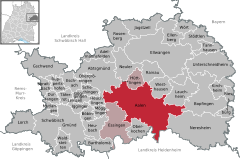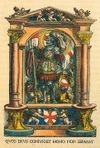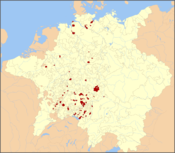Aalen
| Aalen | |
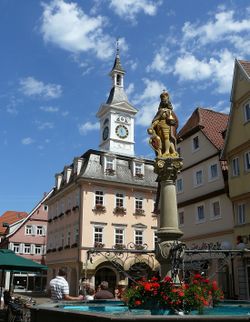 |
|
 |
|
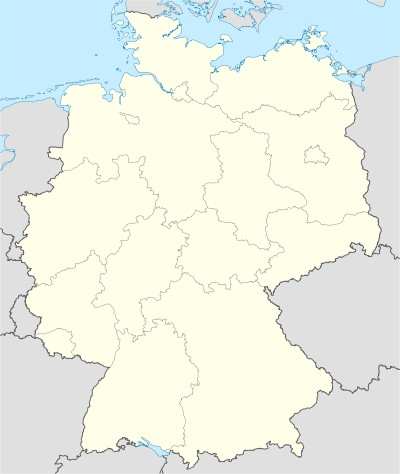 Aalen
|
|
|
Location of the town of Aalen within Ostalbkreis district
|
|
|---|---|
| Coordinates | |
| Administration | |
| Country | Germany |
| State | Baden-Württemberg |
| Admin. region | Stuttgart |
| District | Ostalbkreis |
| Mayor | Martin Gerlach |
| Basic statistics | |
| Area | 146.624 km2 (56.612 sq mi) |
| Elevation | 430 m (1411 ft) |
| Population | 66,196 (31 December 2009)[1] |
| - Density | 451 /km2 (1,169 /sq mi) |
| Other information | |
| Time zone | CET/CEST (UTC+1/+2) |
| Licence plate | AA |
| Postal codes | 73430–73434 |
| Area codes | 07361/-66/-67 |
| Website | www.aalen.de |
|
|||||||||||||||||||||||||||||
Aalen (German pronunciation: [ˈaːlən]) is a town in the German state of Baden-Württemberg. It is the seat of the Ostalbkreis district, and its largest town.
Contents |
Geography
Aalen is situated on the upper reaches of the river Kocher, at the foot of the Swabian Alb to the south and south east and close to the hilly landscape of the Ellwanger Berge to the north. The Aal is a small river stretching only on the town's territory.[2] Aalen is at about 70 kilometres east of Stuttgart and 48 kilometres[3] (30 miles) north of Ulm.
History
From about 150 / 160 AD a Roman fort housed the cavalry unit Ala II Flavia milliaria at the site of present-day Aalen. The location was strategically important at the time, in the direct vicinity of the Rhaetian Limes. The unit being 1000 soldiers strong, the fort was the greatest fort of auxiliaries along the border to unoccupied Germania. A civilian settlement was adjacent on the south and the east. Around 260, the Romans gave up the fort as they withdrew their frontier to Germania back to the Rhine and Danube rivers, and the Alamanni took over the region.[4] It has been suggested that the name of Aalen traces back to the Roman fort, but this was disproved by later research.
The first time Aalen was mentioned in the Middle Ages was in an inventory list of Ellwangen, dated ca. 1136, as the village Alon[4]. Aalen was probably granted town privileges in the 13th century, though it is not certain whether by the Staufians or by the counts of Oettingen. It was first mentioned in written records in the 14th century when it was subject to the counts of Oettingen. Aalen was an Imperial City (often misreferred to as Imperial Free City) from 1360 to 1803, when it was annexed to Württemberg. It suffered a severe fire in 1634.[3] It then became the seat of an Oberamt from which the district (Kreis) Aalen emerged in 1938. The latter merged with the district of Schwäbisch Gmünd to the newly formed Ostalbkreis in 1973, though Aalen remained the district seat. In 1975, Wasseralfingen, a town with a third of the population of Aalen, was merged into Aalen.[3]
Economy
In the early 20th century the population was 10,000. Wool and linen goods were manufactured, there were ribbon looms and tanneries in the town, and a large iron works in the neighbourhood. The economy of Aalen is today dominated by metal processing. Besides machine construction, the optical sector plays an important role, as well as the textile and paper industries. There are several microbreweries, of which the one in Wasseralfingen is the most popular with a beer called Wasseralfinger.
Its church of Saint Nicholas dates back to 1765; the town hall dates back even further, to 1636. In addition to its historical sites, Aalen's Limesmuseum of Roman relics was opened in 1964.[3]
Aalen is a health resort, with the Limes-Thermen (German: “Limes Thermae”) hot springs. The Tiefer Stollen (German: “deep adit”) mine, where ore was once mined for the iron works in Wasseralfingen, now offers therapy for asthma and has a mining museum open for visitors. A mine railway takes visitors deep into the Braunenberg mountain.
Transport
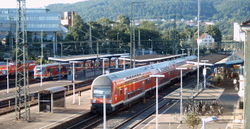
Aalen is located directly on the Autobahn A7 and is also well connected to the network of federal roads (Bundesstraßen).
The Aalen train station is a regional railway hub, with InterCity trains running Karlsruhe–Stuttgart–Aalen–Nürnberg, and regional trains connecting with Stuttgart, Ulm, Crailsheim and Donauwörth.
The local bus system is of high quality; its double-decker buses are among the few in use in Germany.
Windpark Waldhausen
Windpark Waldhausen began operating in early 2007. It consists of seven REpower MM92 wind turbines with a nameplate capacity of 2 MW each.[5] The hub height of each wind turbine is 100 metres (330 ft), with a rotor diameter of 92 metres (302 ft).
|
|
|
Sport
Aalen has several sport teams. The Scholz Arena is the home stadium of the VfR Aalen football club. Aalen's wrestling team KSV Aalen is one of the top clubs in all of Germany, so is the wrestling division of the TSV Dewangen, resident in Aalen's borough of Dewangen.
Boroughs of Aalen
- Dewangen
- Ebnat
- Fachsenfeld
- Unterkochen
- Waldhausen
- Wasseralfingen
International relations
Aalen is twinned with:
 Saint-Lô, France (since 1978)
Saint-Lô, France (since 1978)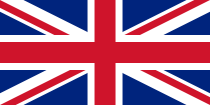 Christchurch, United Kingdom (since 1981)
Christchurch, United Kingdom (since 1981) Tatabánya, Hungary (since 1987)
Tatabánya, Hungary (since 1987)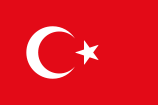 Antakya, Turkey (since 1995)
Antakya, Turkey (since 1995)
Image gallery
|
|
|
References
- ↑ "Bevölkerung und Erwerbstätigkeit" (in German). Statistisches Landesamt Baden-Württemberg. 31 December 2009. http://www.statistik.baden-wuerttemberg.de/Veroeffentl/Statistische_Berichte/3126_09001.pdf.
- ↑ Geographical information system of the town of Aalen
- ↑ 3.0 3.1 3.2 3.3 Aalen, Encyclopædia Britannica; retrieved December 12, 2006, from Encyclopædia Britannica Online
- ↑ 4.0 4.1 Diethelm Winter, ed (1992) (in German). Der Ostalbkreis (2nd edition ed.). Theiss, Stuttgart, Germany. pp. 315–320. ISBN 3-8062-0891-3.
- ↑ "Technische Daten der Windkraftanlagen in Waldhausen (Technical data of wind turbines in Waldhausen)". Windpark Waldhausen. http://www.windparkwaldhausen.de/content-75-technische_daten.html. Retrieved 2008-12-05.
 This article incorporates text from a publication now in the public domain: Chisholm, Hugh, ed (1911). Encyclopædia Britannica (Eleventh ed.). Cambridge University Press.
This article incorporates text from a publication now in the public domain: Chisholm, Hugh, ed (1911). Encyclopædia Britannica (Eleventh ed.). Cambridge University Press.
|
|||||||||||||
|
|||||||||||||||||||
|
||||||||||||||||||||||||
|
|||||||
